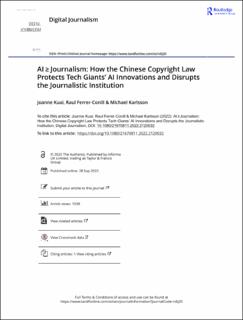| dc.contributor.author | Kuai, Joanne | |
| dc.contributor.author | Ferrer-Conill, Raul | |
| dc.contributor.author | Karlsson, Michael | |
| dc.date.accessioned | 2023-01-04T08:30:45Z | |
| dc.date.available | 2023-01-04T08:30:45Z | |
| dc.date.created | 2022-11-23T09:15:48Z | |
| dc.date.issued | 2022 | |
| dc.identifier.citation | Kuai, J., Ferrer-Conill, R., & Karlsson, M. (2022). AI≥ Journalism: How the Chinese Copyright Law Protects Tech Giants’ AI Innovations and Disrupts the Journalistic Institution. Digital Journalism, 10(10), 1893-1912. | en_US |
| dc.identifier.issn | 2167-0811 | |
| dc.identifier.uri | https://hdl.handle.net/11250/3040829 | |
| dc.description.abstract | Journalism and other institutions clash over automated news generation, algorithmic distribution and content ownership worldwide. AI policies are the main mechanisms that establish and organise the hierarchies among these institutions. Few studies, however, have explored the normative dimension of AI in policymaking in journalism, especially beyond the West. This case study inspects the copyright law’s impact on AI innovation in newsrooms in the unexamined Chinese context. Using neo-institutional theory and policy network theory, the study investigates the Third Amendment to the Chinese Copyright Law, exemplary court cases regarding automated journalism copyright disputes (such as Tencent v. Yingxun and Film v. Baidu), and other supporting documents. The findings show how China’s copyright legal framework separates authorship and ownership; defines “originality” and “creativity” in human-machine collaboration; and prioritises tech companies while undermining journalistic autonomy. We argue that the law’s eager embrace of AI may give tech companies an advantage over news organisations that do not necessarily have a strategy to adopt AI. Moreover, it favours state-owned, resource-rich official media over the private sector. An implication of this shifting power dynamic is the possibility of privately owned news media being marginalised, resulting in even stronger state control over media production and information flow. | en_US |
| dc.language.iso | eng | en_US |
| dc.publisher | Routledge | en_US |
| dc.rights | Navngivelse 4.0 Internasjonal | * |
| dc.rights.uri | http://creativecommons.org/licenses/by/4.0/deed.no | * |
| dc.title | AI ≥ Journalism: How the Chinese Copyright Law Protects Tech Giants’ AI Innovations and Disrupts the Journalistic Institution | en_US |
| dc.title.alternative | AI ≥ Journalism: How the Chinese Copyright Law Protects Tech Giants’ AI Innovations and Disrupts the Journalistic Institution | en_US |
| dc.type | Peer reviewed | en_US |
| dc.type | Journal article | en_US |
| dc.description.version | publishedVersion | en_US |
| dc.rights.holder | The author | en_US |
| dc.subject.nsi | VDP::Samfunnsvitenskap: 200 | en_US |
| dc.source.journal | Digital Journalism | en_US |
| dc.identifier.doi | 10.1080/21670811.2022.2120032 | |
| dc.identifier.cristin | 2078846 | |
| cristin.ispublished | true | |
| cristin.fulltext | original | |
| cristin.qualitycode | 2 | |

